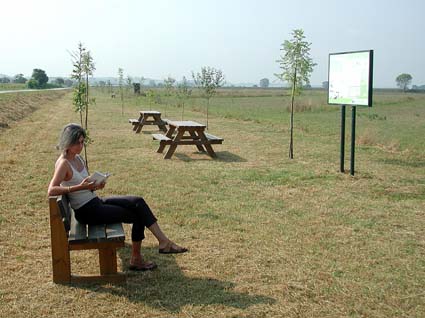
Environmental restoration work and establishing a rest area within the track system of the Padule di Fucecchio
Mechanized farming has swept away most of the numerous hedges and tree belts which used to border fields and provide useful products such as wood, fruit and forage to the people living on the neighbouring farms.
Hedges and avenues of trees served an important function in the country landscape both as linking and diversifying elements. In modern environment restoration practices they constitute “ecological corridors”, reducing to some extent negative effects resulting from habitat fragmentation of both animal and vegetal species.
A wooded hedge has been planted along a tract of the old bed of the stream Vincio (at Vincio Vecchio, Stabbia) and a rest area for visitors and hikers has been set up.
Being similar to the few natural hedges still existing in the area, this hedge harmoniously blends with the surrounding landscape.
The White Poplar has been chosen as the dominant tree species while shrubs include the Hawthorn, the Blackthorn and the Dogwood. Other tree species have also been inserted, which used to be widespread in the area and which provide food to a number of animal species; these include the Walnut, the English Oak, the European Alder and the Black Mulberry.
The testimonies of the historical drainage works
This wooded hedge lies on a stretch of state property resulting from the filling of the old bed of the stream Vincio; this water course was long used to carry out drainage works, which, starting from the 17th century, made it possible to reclaim new farm land from the marshes.
The drainage “by filling”, along with other practices aimed at favouring the outflow of the water in the marsh, was for centuries the most widespread drainage technique.
In order to drain a piece of land, the surface to reclaim was embanked and one or more tributaries of the marsh, very rich in debris, was made to flow into the embanked area, thus causing its level to rise. To achieve the desired results, it was necessary to regulate the regime of the water in the basin by means of gates that were positioned and operated so as to make the most of the materials swept along by the stream and slowly building up on the surface.
The stream Vincio was thus channelled away from its bed to serve the areas selected for drainage. Its old beds, which were subsequently filled, are still visible, at tracts, thanks to the presence of some of the hydraulic works that used to be part of the complex system of water regulation.
Today preserving what remains of these works (which were partly removed to give way to mechanized farming) represents a necessary tribute to the ingeniousness and industry of the people living in the marsh area.



